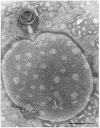Phages in the Human Body
- PMID: 28421059
- PMCID: PMC5378999
- DOI: 10.3389/fmicb.2017.00566
Phages in the Human Body
Abstract
Bacteriophages, viruses that infect bacteria, have re-emerged as powerful regulators of bacterial populations in natural ecosystems. Phages invade the human body, just as they do other natural environments, to such an extent that they are the most numerous group in the human virome. This was only revealed in recent metagenomic studies, despite the fact that the presence of phages in the human body was reported decades ago. The influence of the presence of phages in humans has yet to be evaluated; but as in marine environments, a clear role in the regulation of bacterial populations could be envisaged, that might have an impact on human health. Moreover, phages are excellent vehicles of genetic transfer, and they contribute to the evolution of bacterial cells in the human body by spreading and acquiring DNA horizontally. The abundance of phages in the human body does not pass unnoticed and the immune system reacts to them, although it is not clear to what extent. Finally, the presence of phages in human samples, which most of the time is not considered, can influence and bias microbiological and molecular results; and, in view of the evidences, some studies suggest that more attention needs to be paid to their interference.
Keywords: bacteriophages; diagnosis; homeostasis; human biomes; metagenomics; virome.
Figures
References
-
- Asadulghani M., Ogura Y., Ooka T., Itoh T., Sawaguchi A., Iguchi A., et al. (2009). The defective prophage pool of Escherichia coli O157: prophage-prophage interactions potentiate horizontal transfer of virulence determinants. PLoS Pathog. 5:e1000408 10.1371/journal.ppat.1000408 - DOI - PMC - PubMed
-
- Bacon E. J., Richmond S. J., Wood D. J., Stirling P., Bevan B. J., Chalmers W. S. (2017). Serological detection of phage infection in Chlamydia psittaci recovered from ducks. Vet. Rec. 119 618–620. - PubMed
Publication types
LinkOut - more resources
Full Text Sources
Other Literature Sources



